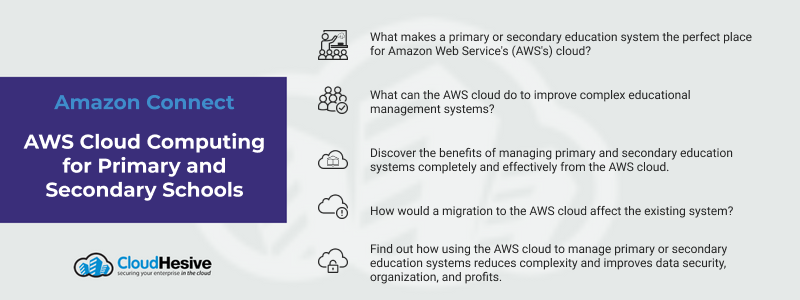Managing the flow and effectiveness of primary and secondary education systems can be relatively complex. Above all, it’s vital that they’re serving their intended purpose and helping students retain necessary information. This is where the AWS cloud can help, as it can easily streamline many of the known pain points of education systems.

Technology continues to find its way into education, which has proven extremely useful for students of all ages. Although this is true, many areas of education need to catch up to speed with the capabilities of today’s technology. Many education systems in primary and secondary schools face numerous inefficiencies that can hinder the learning process with student bodies. With the help of AWS cloud infrastructure, students and teachers can benefit from a scalable, secure, and cost-effective learning environment.
Education systems will be able to improve accessibility across the board and lower costs, giving them more flexibility for the needs of their students. The adaptability of AWS cloud computing offers schools and teachers the ability to cater to the subject or student body at hand. Whether they’re working with pre-schoolers or seniors in high school, AWS cloud computing can benefit them all.
AWS cloud computing works across various education mediums, including teachers, students, researchers, and administrators. It helps to digitize the learning process and give classrooms easier access to widespread information and learning experiences that may otherwise not be possible. Over 14,000 education institutions use AWS cloud computing to their advantage, and this number continues to increase. To use AWS to its fullest potential, it’s essential to understand precisely what it does and how you can apply it to education.
How AWS can help education systems
With a focus on modernizing education from multiple angles, AWS brings a broad range of benefits to the table. From primary and secondary schools to higher education, technology can adapt to the requirements of different levels of learning. What many education systems like about this approach the most is its cost efficiency. When you compare it to many traditional tools and methods in education, AWS is a far cheaper solution. It also allows educators to dive deeper into education on multiple fronts.
Some of the core benefits AWS provides the education industry include:
- Personalized student learning experiences
- Comprehensive data on student performance
- Improvements in efficiency and cost reduction
- Provides unparalleled security, agility, and innovation
- Modernizes the learning experience for future generations
Learning is a core focus in education systems, but administrators also have to worry about managing these systems, which poses challenges. From another aspect, online learning has become increasingly common in recent years. Although education technology has existed for quite a long time, online learning is now the norm for many people. Undoubtedly, AWS cloud computing can excel here and make the entire process more intuitive for students.
Full-fledged management with AWS cloud computing
School districts can have much more control over how their education systems are managed using AWS cloud computing. It can do wonders for modernizing and securing institutions inside and out. For example, the technology supports 98 security standards and compliance certifications. It also can deliver reliable, secure, and scalable data storage and migration of existing databases.
Transitioning to such technology doesn’t have to come with a total wipe of the work that administrators and school districts have done. All it does is transition that information to a digital space while giving you much more flexibility and adaptability. Thanks to quick and effective disaster recovery tools, you’ll find it can easily minimize downtime and data loss.
AWS has various tools that allow administrators and school districts to manage education systems from every angle, but it doesn’t stop there. It also gives you the flexibility to build and deploy solutions that cater to the exact needs of your education system management.
Some of the categories include:
- Teaching and learning
- Administrative and operations
- Cybersecurity
- Data and analytics
- Essential infrastructure systems
This is vital as many schools serve a core purpose, and most don’t follow a cookie-cutter approach to education. That way, you can still benefit from what AWS offers while making it work in the best interest of any education system.
Reducing the overall complexity of education
Another major benefit of AWS cloud computing is that it can bring a new level of organization that many education systems desperately need. Using cloud technology can offer many advantages, but efficiency and organization are winning points from an educational standpoint. Teachers, administrators, and school districts can move forward cohesively and fluidly. This inherently benefits students’ learning experience while doing their jobs a little easier daily.
Moreover, the pay-as-you-go pricing model of cloud computing makes each decision much more cost-efficient. This opens up more funds for the needs of education systems and makes it much more accessible for each student involved. Systems can be less convoluted by using a variety of IT resources at will, with near-instant availability. There are many unpredictable happenings regarding the management of education systems, as they can be rather vast.
Using AWS to benefit education system management will help streamline the entire process without compromising the direction of the students or institution in question. Reviewing our numerous case studies, you can learn more about how AWS cloud computing can benefit primary and secondary educational systems. They dive deeper into the real-life scenarios where others are using AWS and how it can adapt to changing needs of different environments and industries.



